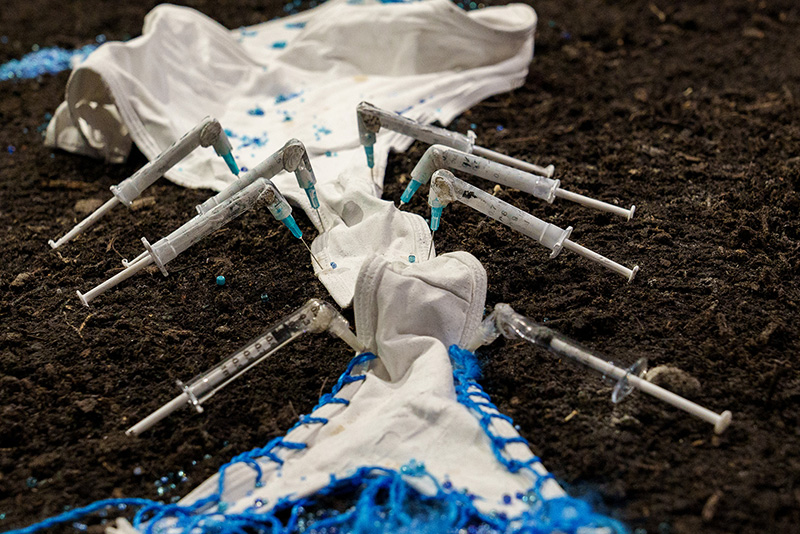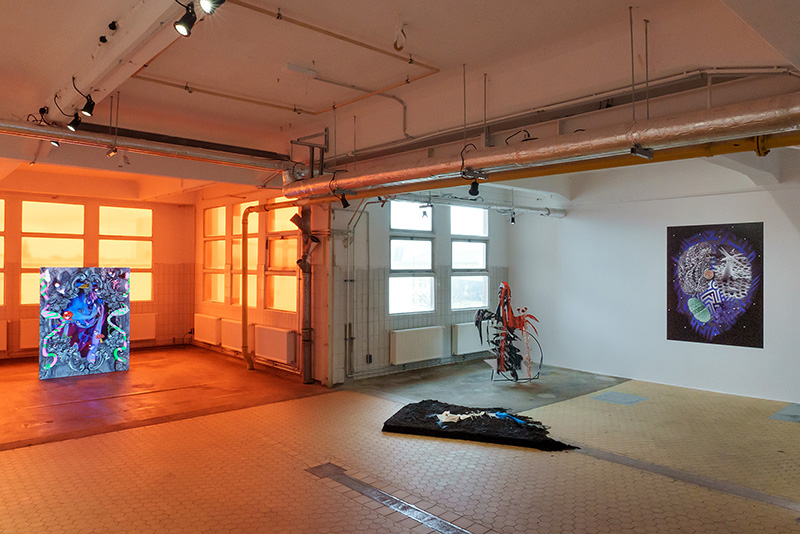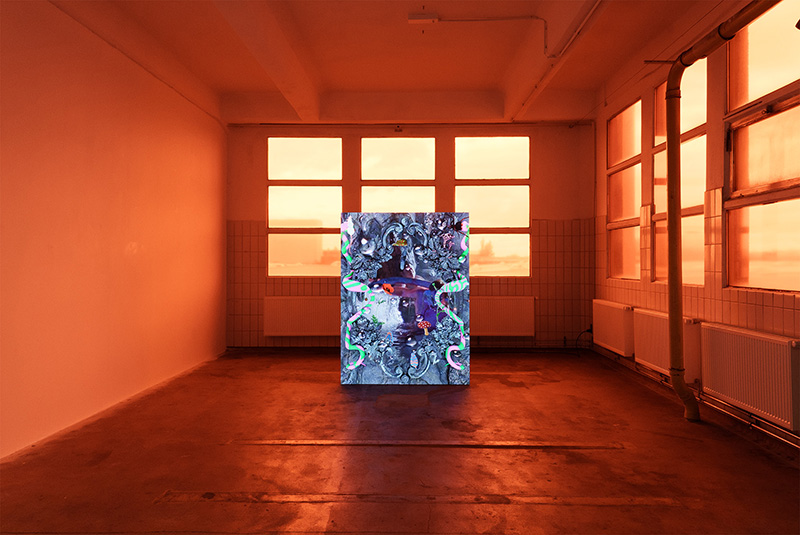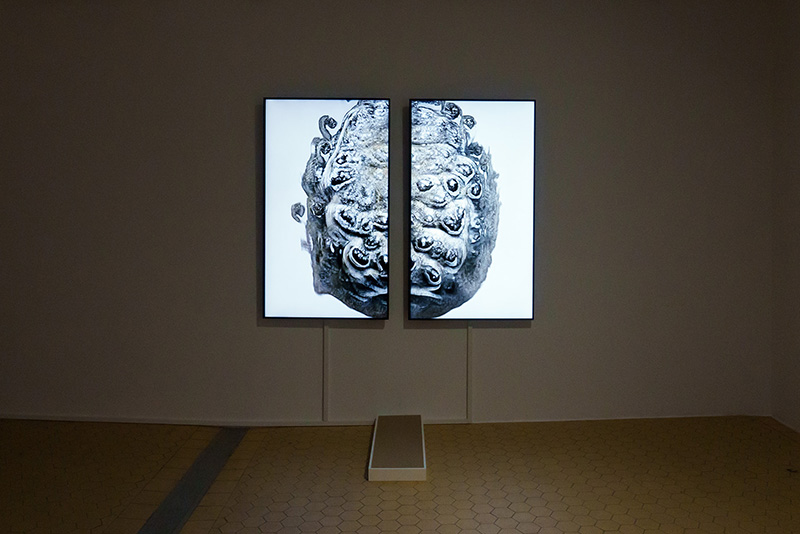by Moses Hubbard // Nov. 15, 2022
‘Don’t Panic,’ on view at soft power until November 20, is part of 3hd 2022, the annual interdisciplinary festival from Berlin-based art platform Creamcake. The exhibition brings together works from a number of young contemporary artists—George Henry Longly, JAZSALYN, Katja Novitskova, Lito Kattou, Sofia Moreno, and Tianzhou Chen—who all address the experience of being alive in a period of time when there is in fact quite a lot to panic about. The selection can perhaps be most usefully understood as a catalog of the aesthetic and thematic sensibilities that have developed in the contemporary art scene during a prolonged period of global anxiety. The artists employ private, often cryptic symbol systems, which speak to a rich interiority and also, perhaps, a hesitancy to become too available to interpretation.

Sofia Moreno: ‘Autoretrato como ofrenda sobre tierra/ Selfportrait as offering on soil,’ 2022, 3hd 2022: ‘Don’t Panic’ // Photo by ink Agop, Courtesy of Creamcake
Soft power is a single stripped-down room on the third floor of an industrial warehouse building, a closer aesthetic relative to an artist’s studio than the white-box galleries that populate Karl-Marx Allee or Kudamm. The bare-bones functionality of the exhibition space accentuates the quality of the works, a reminder that these pieces can (and do) hold their own in more polished environs—Katja Novitskova, for example, has exhibited work in Sammlung Boros, the Hamburger Bahnhof, Art Basel, and MoMA. To their credit, the curators seem to have leaned into the DIY-vibe. The works are arranged unfussily, roughly one piece per section of wall, while also installed in a way that encourages contrast and comparison between the works. This is not the sort of group show that gets slapped together just because everyone happens to know each other; the pieces have been carefully selected and ordered for maximum effect.

3hd 2022: ‘Don’t Panic,’ installation view // Photo by ink Agop, Courtesy of Creamcake
The most visually arresting of the works in ‘Don’t Panic’ is a video installation by Tianzhuo Chen, which consists of a series of short films—‘ADHA – Rebirth’ (2021), ‘Illusion’ (2021), ‘blue snake burning nude’ (2022), ‘Ten billion sand’ (2021), ‘Seream’ (2021), and ‘Mount Sumeru’ (2021). The films are structured like animated cards, each of which is constituted by a potpourri of images—scorpions, tree branches, dancing skeletons, a severed hand, spinning globes, a disembodied intestine, and a rotating figure that appears to be doing the ball-tuck thing from ‘The Silence of the Lambs,’ to name just a few. Watching these images cycle by, you may suspect that if you watch for long enough you’ll start to identify layers upon layers of coded meaning. Perhaps Chen’s way of not panicking is to create a world in which he assigns his own meanings, creating a tarot deck from which to divine.

Tianzhuo Chen: ‘Seream,’ 2021, 3hd 2022: ‘Don’t Panic’ // Photo by ink Agop, Courtesy of Creamcake
Another notable moment is Sofia Moreno’s ‘Selfportrait as offering on soil’ (2022), which lies in the middle of the gallery space. The piece consists of a trapezoid-shaped pile of raw earth, approximately 10 centimeters thick, on top of which is an assemblage of beads, fabric, and used syringes that closely resemble a flattened centipede. Two sides of the soil trapezoid somehow maintain a 90-degree angle with the floor, while the other sides crumble apart. The effect is surprisingly engrossing; you may even start to worry about the soil, hoping that the right-angled sides don’t fall apart. The crumbling section of earth—alone, unprotected, spread out on the tiled floor—seems to struggle to retain its own form. Although the centipede assemblage centers the work, it is the soil that feels like the heart of the piece, and the element that comes closest to a form of portraiture. Here, again, there is a sense that a discrete symbol system is at work—the exhibition text mentions that Moreno makes use of Mesoamerican mythology—although neither the text nor the piece itself explicates this system further.

JAZSALYN: ‘REIMAGINE Prototype 002,’ 2020-22, 3hd 2022: ‘Don’t Panic’ // Photo by Ink Agop, Courtesy of Creamcake
Why all these different symbologies, and why the reluctance to make them legible to the outside viewer? One explanation might be that, in the face of endless crises so far outside of our control, people find solace in systems of meaning-making that aren’t accommodating to (and therefore digestible by) the metabolism of globalized capital. A possible key is JAZSALYN’s ‘Reimagine Prototype 002’ (2020-2022), in which the artist has integrated indigenous artifacts into artificial intelligence systems, seeking to “re-indigenize” these algorithms. JAZSALYN’s work takes this resistance a step further, mystifying the very systems that have historically been used to quantify and extract value. Such moments of personal revolt are meaningful in themselves; they give us a chance, however fleeting, to live in a world of our own choosing.
Exhibition Info
soft power
‘Don’t Panic’
Exhibition: Oct. 21–Nov. 20, 2022
3hd-festival.com
Teilestraße 11-13 Hof 2, 3.OG, Aufgang C, 12099 Berlin, click here for map





















